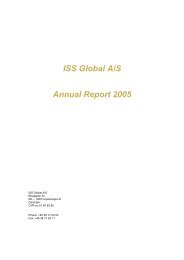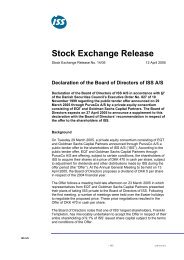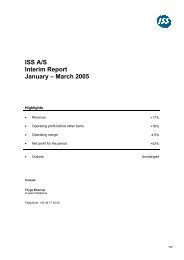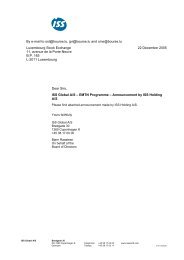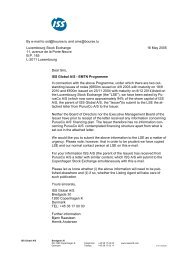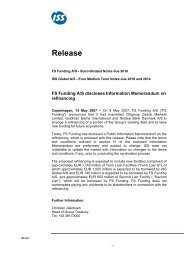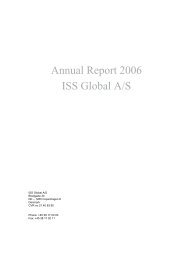I. Table of Contents - ISS
I. Table of Contents - ISS
I. Table of Contents - ISS
You also want an ePaper? Increase the reach of your titles
YUMPU automatically turns print PDFs into web optimized ePapers that Google loves.
tatiana\Bank Book\Public Bank Book\FINAL <strong>ISS</strong> PUBLIC Bank IM - Press Release to EMTN_1.doc 9 Nov 2005 10:32 74/91<br />
74<br />
Historical Financial Information<br />
Current Assets<br />
Current assets (less liquid funds) amounted to 18.9% <strong>of</strong> revenues in 2004, which is a decline<br />
compared to 2000 when it accounted for 19.2%. This relative decline in current assets has been driven<br />
by accounts receivables, which represent approximately 84% <strong>of</strong> total current assets. The number <strong>of</strong><br />
days <strong>of</strong> revenues outstanding has been stable in 2004 but is lower than the higher levels in 2001 (49<br />
days) and 2002 (47 days).<br />
Inventories comprise mainly raw materials, supplies and finished goods. Contract work in progress has<br />
increased in the period 2000-2004 with the exception <strong>of</strong> 2003 when it decreased. The increase is<br />
related to management focusing more on integrated facility services, and also the fact that contracts<br />
are increasing in size and scope.<br />
Current Liabilities<br />
The majority <strong>of</strong> current liabilities relate to employee-related liabilities such as accrued salaries and<br />
holiday allowances. Trade payables increased in the period 2000-2004, but the increase is in line with<br />
the development <strong>of</strong> cost <strong>of</strong> goods sold and other operating expenses, hence current liabilities in<br />
relation to revenues have remained stable. Current liabilities have been impacted by an increase in<br />
prepayments from customers, as the company has continuously focused on generating cash flows.<br />
Total Non-Current Liabilities<br />
Provisions include pensions, deferred tax liabilities, and other provisions. As the company operates in<br />
various countries, there are different forms <strong>of</strong> pension schemes. The Group contributes to defined<br />
contribution plans as well as defined benefit plans. As <strong>of</strong> September 30, 2005, the Company had<br />
pension and similar obligations on its balance sheet equal to DKK 802 million, which comprise pension<br />
in relation to the defined benefit plans 14 . Provisions increased in the first nine months <strong>of</strong> 2005 due to<br />
adoption <strong>of</strong> IFRS regarding actuarial losses related to pensions. Other provisions include labour<br />
related items, self insurance, acquisitions and other which combined, have remained stable at around<br />
1.4% - 1.6% <strong>of</strong> revenues during 2000-2004 under Danish GAAP.<br />
14 <strong>ISS</strong> contributes to defined contribution plans as well as defined benefit plans. The majority <strong>of</strong> the pension plans are funded through payments<br />
<strong>of</strong> annual premiums to independent insurance companies responsible for the pension obligation towards the employees (defined contribution<br />
plans). In these plans <strong>ISS</strong> has no legal or constructive obligation to pay further contributions irrespective <strong>of</strong> the funding <strong>of</strong> these insurance<br />
companies. Pension costs related to such plans are recorded as expenses when incurred. For further information about <strong>ISS</strong>'s pension<br />
program, please refer to the Mercer Pension Report.



